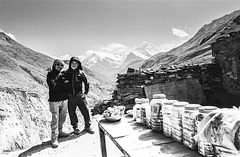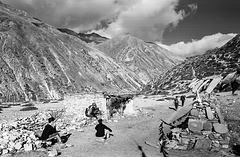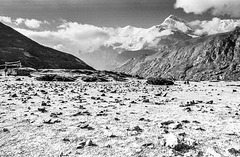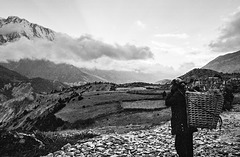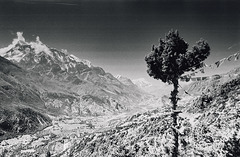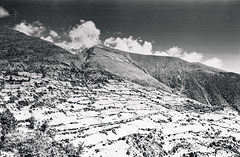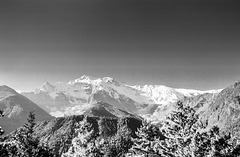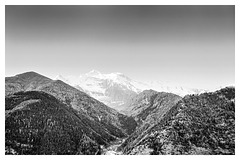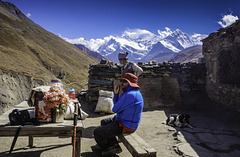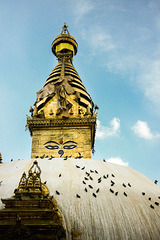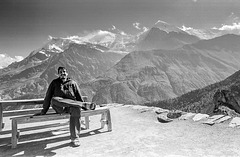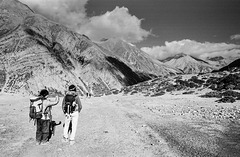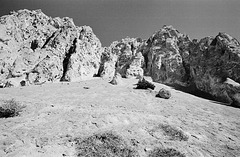m̌ ḫ's photos
Two strong men... and candies
| |
|
|
And here, I should take respect to these men who carried our staff while we were travelling light. Humble and good-spirited duo, after time spending home my respect only grows. Thanks to these people, we can enjoy the nature in its beauty - wish you guys a lot of safe future trips!
Passing a stone cairn, enjoying a small refreshmen…
| |
|
|
In Himalays, the stacks of carefully placed stones translated in english as "cairns" are often aligned beside rivers and at mountain alters, making the path-markers on a trail. While this is true for Nepal as well, cairns hold a much more cultural meaning than just direction-pointers. Both Hinduism and Tibetan Buddhism, two major local religions, have philosophies that indicate every sentient being is connected to the universe. Many cultural symbolisms occur in the form of stones in old legends,including the local shamanistic traditions.Cairns in the Himalayas are also often ornamented with prayer flags, and the stones are often arranged in a certain way, with some even worshipped as altars to the gods.
Closer to the top
| |
|
|
|
Those who never take trekking journey might not know these moments. This is the best part of the journey, you already do not feel any pain, you just walk and walk, enjoy the wide plains. In these moments you just found your inner peace. In these moments you might not take the pictures because it does not matter - to show friends your best moments? you've already clicked the peaks, and then you'll do a final on top. Heh. These parts are for your selves. These parts of journeys are sacred, dreamt, relaxed, filled with inner peace.
Evening in the mountains
| |
|
|
|
Back home
| |
|
|
|
Back home with a basket full of yield
| |
|
|
|
Humde airport from the way to Upper Pisang, trekki…
| |
|
|
|
Manang (Humde) Airport is situated at Manang District, Province No.4. The District is still not connected with the road network and hence the airport serves as a major means of transportation. The airport is situated in the world famous Annapurna round trek route and is located at highest elevation of 11092 ft among the operational airports of the country. This airport also serves as the gateway to Tilicho Lake. caanepal.gov.np/storage/app/media/uploaded-files/Manang%20Airport.pdf
Flights to and from Humde started in July 1982. Back then, two regular flights used to be operated every week from Humde. Locals say that flights stopped when a road track to Manang opened. A flight from Pokhara to Manang takes around 25 minutes, however planes cannot fly to Manang in snowy or rainy weather.
Burned by the Sun
| |
|
|
m a n i s t o n e s
| |
|
|
Mani stones (མ་ཎི་རྡོ་འབུམ།) are stone plates or rocks that are carved with the Tibetan Buddhism six-word mantra Om Mani Padme Hum.
The first word, Om , symbolizes the practitioner’s impure body, speech, and mind; it also symbolizes the pure exalted body, speech, and mind of a Buddha. Mani meaning jewel, symbolizes the factors of method: altruistic intention to practice compassion and love. Padme , meaning lotus, symbolizes wisdom. Purity must be achieved by an indivisible unity of method and wisdom, symbolized by the final syllable Hum , which indicates indivisibility.
Thus the six syllables, om mani padme hum, mean that in dependence on the practice of a path which is an indivisible union of method and wisdom, you can transform your impure body, speech, and mind into the pure exalted body, speech, and mind of a Buddha. But nowadays people also carve other texts from Buddhism.
The Mani stone is the one of the most popular forms of prayer and ritual in Tibetan culture. It’s originally from Bon’s stone worship. When you are traveling to Tibet, you will find a lot of Mani stones. They are intentionally placed along the roadsides and rivers or placed together to form a big stupa, temple and mountain shapes. People also place the Mani stones along walls, as an offering to spirits of a place.
Everyday scene (for some)
| |
|
|
03910002
| |
|
Michal walks around the old village
| |
|
|
Ivan rests
| |
|
|
The Eyes on the Buddhist Stupa of Swayambhu, Kathm…
| |
|
|
|
Find peace and prayers on the little hillock of Swaymbhunath in the northwest of Kathmandu Valley. Visitors for whom the name was a tongue twister have called it "Monkey Temple" from the 1970s. Swayambhu, overlooks most parts of the valley giving visitors a panoramic view of the city. The stupa has stood as a hallmark of faith and harmony for centuries with Hindu temples and deities incorporated in this Buddhist site. The glory of Kathmandu Valley is said to have started from this point.
Resting on a hillock 3 km west of Kathmandu, Swayambhu is one of the holiest Buddhist stupas in Nepal. It is said to have evolved spontaneously when the valley was created out of a primordial lake more than 2,000 years ago. This stupa is the oldest of its kind in Nepal and has numerous shrines and monasteries on its premises.
Swayambhu literally means "self-existent one". Believed to date back to 460 A.D., it was built by King Manadeva and by the 13th century, it had become an important center of Buddhism. Legend has it that Swayambhu was born out of a lotus flower that bloomed in the middle of a lake that once spread across the Kathmandu Valley once was. The largest image of the Sakyamuni Buddha in Nepal sits on a high pedestal on the western boundary of Swayambhu beside the Ring Road. Behind the hilltop is a temple dedicated to Manjusri or Saraswati - the Goddess of learning. Chaityas, statues and shrines of Buddhist and Hindu deities fill the stupa complex. The base of the hill is almost entirely surrounded by prayer wheels and deities. Devotees can be seen circumambulating the stupa at all times.
Somewhere between Manangand & Thorong Pedi appx…
That direction for another 3 days...
| |
|
03970001
| |
|
03920012
| |
|
|

